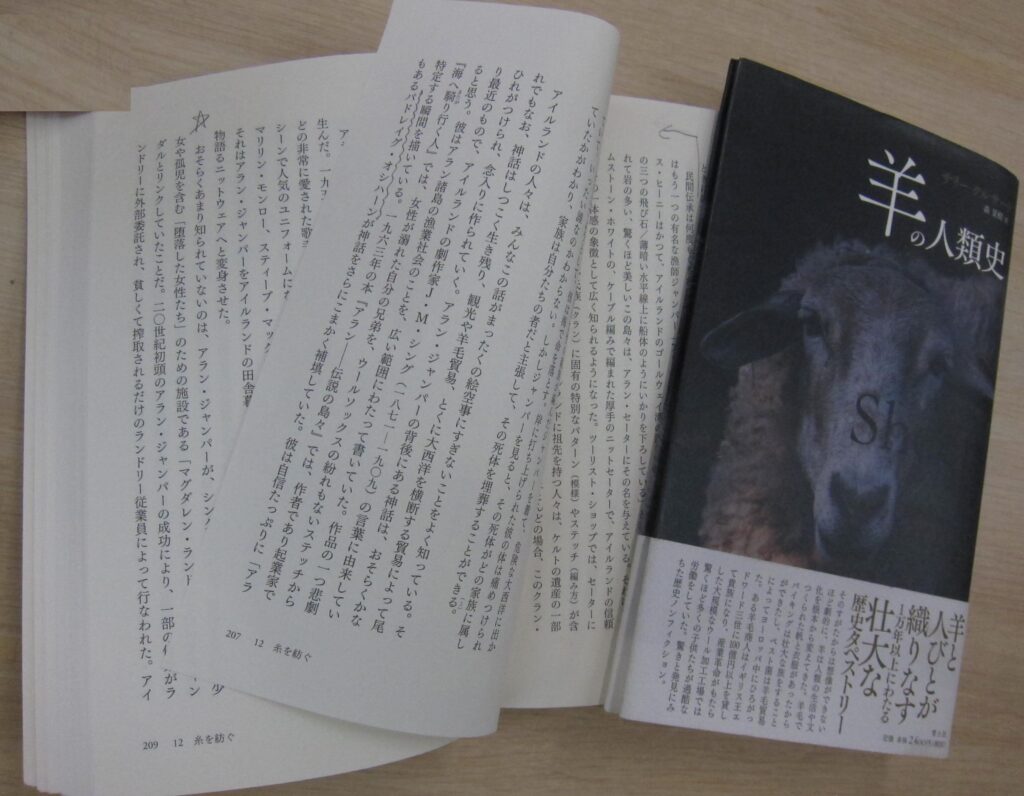English translation at bottom.

昨夏地元の小さな書店で衝動買いした本が、こういう事になってくるとは。「羊の人類史」(サリー・クルサード著、森夏樹訳、青土社・2020年)。
300ページの大作で、内容は面白いのですが、訳(やく)が私と相性が合わないのか、なんだかすんなりと進まなくて、つかえつかえ時間ができたときにゆっくりと読み進めていたのです。羊の起源、羊肉食、生贄、ウールの利用、紡績、産業革命、と、羊が人間社会とどう関わってきたか、が描かれていきます。
何ヶ月か掛かりようやく三分の二を過ぎた頃、ガンジーセーターが登場します。おっこれはもしかしたら、と、わくわくして読み進むと、出ました、アランセーター。ほう、やっぱりセーターと言えば、その代表選手はアランですよね、嬉しいですね。あれ、この名前は何だ、パドレイグ・オシハーン?、これは我が師、パドレイグ・オシォコン、のことだね。Padraig O’Siochainで日本語検索すればすぐに私の著述が出てくるはずなのに、訳者の怠慢だね、シングの戯曲の邦題もちょっと違ってるし、これは出版社に訂正を求めないといけないなぁ。えっ、彼は抜け目のない起業家で、自分のセーターをアメリカに売り込むために、でたらめな伝説をでっち上げた?、って、はぁーっ、それじゃまるであのおじいちゃんが悪徳商人みたいじゃないか。彼は元来厳格な学者・研究者であって、アランの島民の貧困を救うために、アイルランドの素晴らしい伝統手芸品を世界に広げたい、という純粋な動機を持ち、むしろ武士の商法とも言える素人同然のやり方だったし、抜け目のない悪徳商人などとは全く持って正反対の男なんですよ。これは著者に厳重抗議だな。パドレイグの名誉は私が守らないで誰がやるんだ。しかし、英語か、こりゃ原著を取らないといけないなぁ。
さらに読み進むと、私の知らない話が黒歴史のように書いてあります。かの悪名高きマグダレン修道院(註※)では収容する修道女たちにまるで強制労働か虐待のようにアランセーターを編ませてその利益を搾取していた、と。記述箇所の段落も少し離れているからそう思う人は少ないだろうけど、ふたつの記述から、あたかもパドレイグがマグダレン修道院にアランセーターを編ませていた、と、連想する人もいるでしょう。これは由々しきことです。
今までたらたら読んでいたこの本ですが、そこからは急いで完読。次に「マグダレンの祈り」の翻訳本と映画化されたDVD、特典映像のドキュメンタリー番組を確認します。人権を無視した悲惨な場面はたくさん出てきますが、アランセーターを編ませる、というシーンはどこにも出てきません。
と、今回の話はここまでです。なぜなら、これはもう片手間では済まないことになってきた、と、感じ始めてきたからです。アランセーターは私のライフワーク。日本におけるアランセーターの第一人者、と自認する私にとって、このことはしっかりと調べていかないといけない宿題になってしまいました。何年かかかることになるでしょう。
結論が出るまで黙っておくこともできないので、ここらで中間報告代わりに余話で書き留めておくことにしました。いつになるやら、ですが、調査報告の続編をお楽しみに。(弥)
(註※)マクダレン修道院(マグダレン洗濯所)
18世紀に、プロテスタントの教会の施設として「堕落した女」を保護・収容する目的で創設された「マグダレン洗濯所」は、19世紀初頭にはカトリック教会によっても設立・運営されるようになった。
そこに収容されたのは「堕落した女」だけではなかった。そうなる可能性があると(一方的に)みなされた女子、身寄りのない女児などがこの施設に閉じ込められ、過酷な環境でホテルや軍隊の施設などから出るベッドシーツなどの洗濯物を処理する作業を、無報酬で強要された。奴隷労働である。
施設の存在はもちろん知られていたが、完全に閉鎖された施設であり、教会もことを明るみに出すことはなく、そこでの実態は1993年人手に渡った施設の敷地内から大勢の胎児乳幼児の遺体が発見されるまで、外部には一切知られていなかった。施設の最後の1軒が閉鎖されたのは、1996年である。
1950年代のアイルランド・ダブリンで助産師としてこれらの施設のひとつに関わった女性の手記「マグダレンの祈り」は映画化もされている。
※著者にこのコラムを読んでもらうため、英訳を下記に載せます。
Club column [426] Black history of the Aran Sweater? (1 April 2024)
I never thought this would happen to a book I bought on impulse at a small local bookshop last summer. The Human History of Sheep (Originally titled: A Short History of the World According to Sheep) (written by Sally Coulthard and translated by Natsuki Mori, Seidosha, 2020).
It is a large work of 300 pages, and the content is interesting, but the translation does not suit me, or perhaps it did not go smoothly, so I read it slowly when I had time to catch up. The book describes the origins of sheep, mutton eating, sacrifice, the use of wool, spinning and the industrial revolution, and how sheep have interacted with human society.
After several months and finally two-thirds of the way through, the Guernsey jumper appears. I was excited to read on, and there it was, the Aran jumper. I was delighted to see that, when it comes to jumpers, Aran is the most popular player. What is this name, Padraig Oshihaan? I’m sure if we do a Japanese search for Padraig O’Siochain we’ll find my writings right away, but it’s the translator’s negligence, the Japanese title of Sing’s play is also a bit different, which I have to ask the publishers to correct! Nah. What, he’s a shrewd entrepreneur who made up some bullshit legend to sell his jumpers to America? That makes the old man sound like a crook, doesn’t it? He was a rigorous scholar and researcher by nature, with a genuine motive to help the islanders of Arran out of poverty and to spread the wonderful traditional Irish handicrafts to the world, rather like an amateur in the business practices of a warrior, and the complete opposite of a shrewd and corrupt merchant. This is a strict protest against the author. If I don’t defend Padraig’s honour, who will? But English, I’ll have to get the original book.
When I read further, there are stories I don’t know about, like black history. The infamous Magdalene convent (note*) exploited its profits by making the nuns it housed knit Aran jumpers as if they were forced labour or abused. Although few people would think so because the paragraphs are a bit far apart, some people might associate the two statements as if Padraig was having Aran jumpers knitted in the Magdalene convent. This is venerable.
This book has been a lazy read so far, but from there it is a hasty and complete read. Next, check the translated book and the DVD of the film adaptation of The Magdalene Prayer, as well as the bonus documentary programme. There are many harrowing scenes of disregard for human rights, but nowhere do you see the scene where they make you knit an Aran jumper.
And that’s the end of this story. Because I am beginning to feel that this is no longer a one-sided affair. Aran jumpers are my life’s work. As the leading authority on Aran jumpers in Japan, this has become a homework assignment that I have to look into thoroughly. It will take years. I can’t keep quiet until a conclusion is reached, so I’ve decided to write it down here as an afterthought instead of an interim report. I don’t know when that will be, but look forward to the sequel to the investigation report.
(Yaichiro)
(Note*) Magdalen Convent (Magdalen Laundries) Founded in the 18th century as a Protestant church institution to protect and house ‘fallen women’, the Magdalen Laundries were also established and operated by the Catholic Church in the early 19th century. It was not only ‘fallen women’ who were housed there. Girls who were (unilaterally) deemed to have the potential to become so, as well as girls without relatives, were confined to these facilities and forced to work in harsh conditions to dispose of bed sheets and other laundry from hotels, military installations, etc., without pay. It was slave labour. The existence of the facilities was known, of course, but they were completely closed and the Church did not bring it to light, and the reality of the situation there was not known to the outside world until 1993, when the bodies of many unborn babies were found on the premises of the facilities in human hands. The last of the institutions was closed in 1996. The Magdalene Prayer, the memoir of a woman who was involved with one of these facilities as a midwife in Dublin, Ireland in the 1950s, has been made into a film.
![JACK NOZAWAYA [倶樂部余話]](https://www.savilerowclub.com/yowa/wp-content/uploads/2016/07/sample1.jpg)